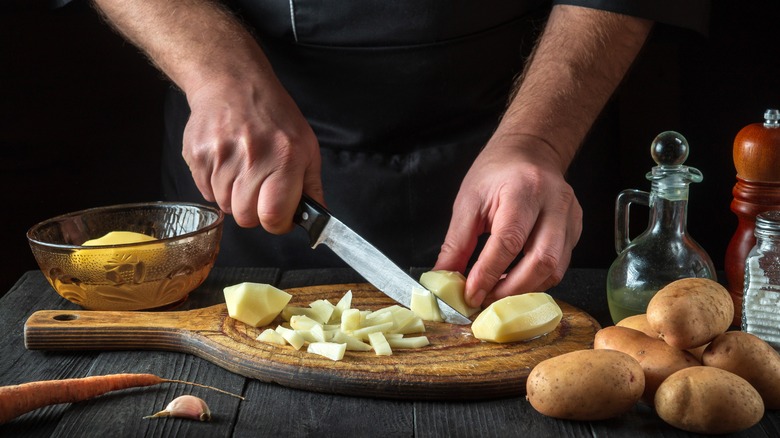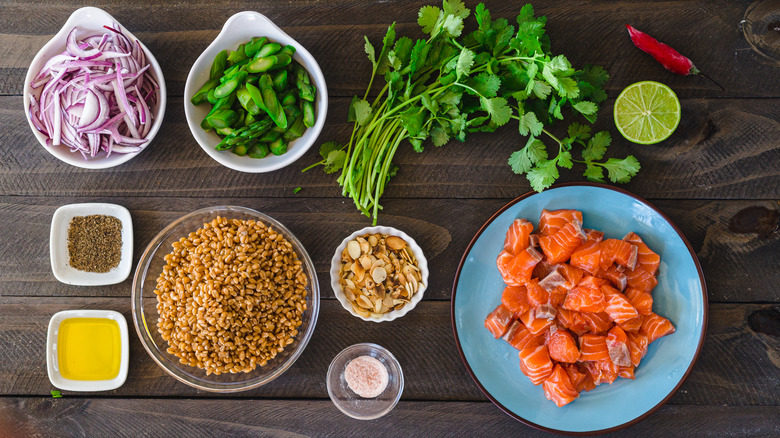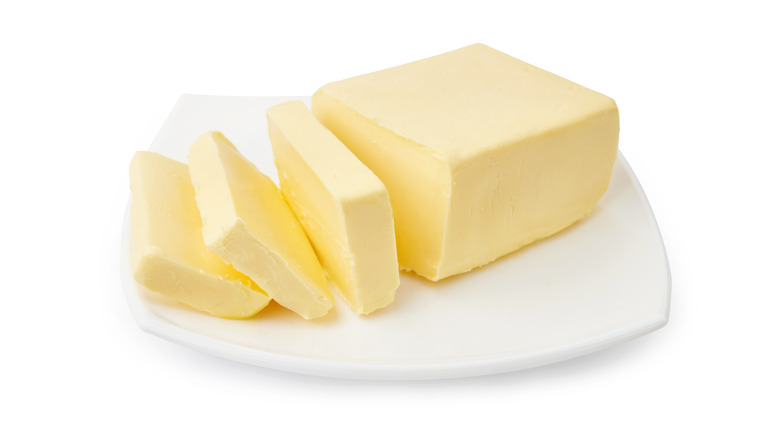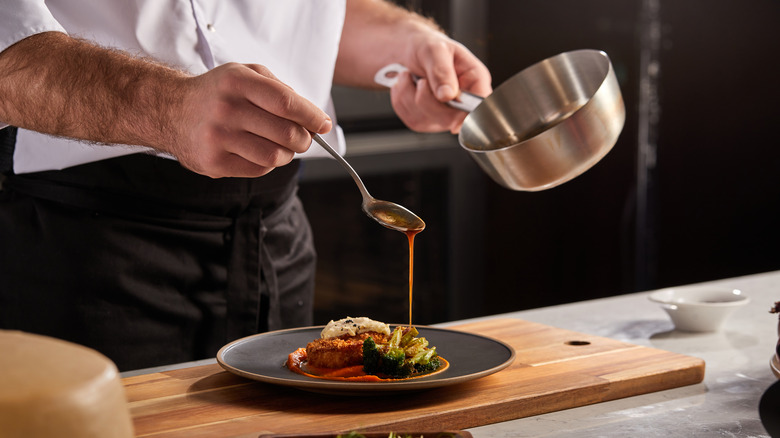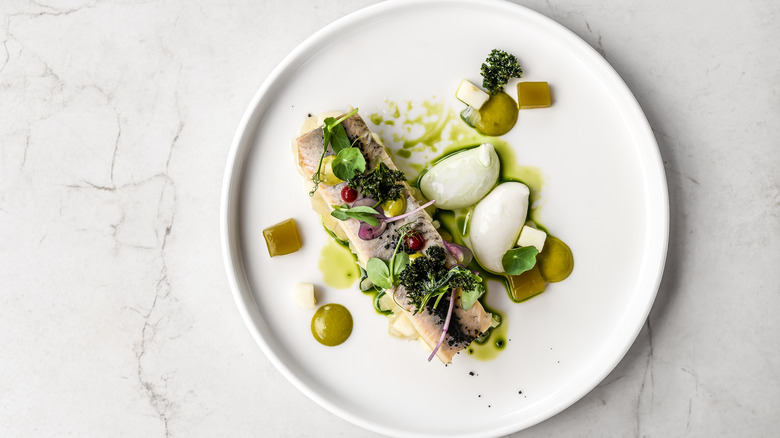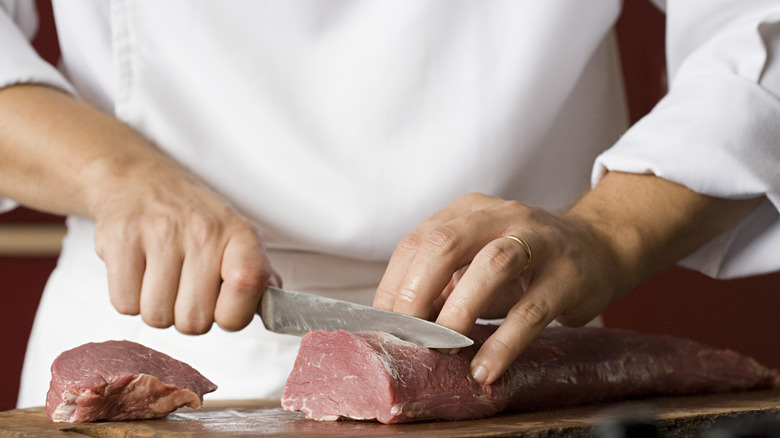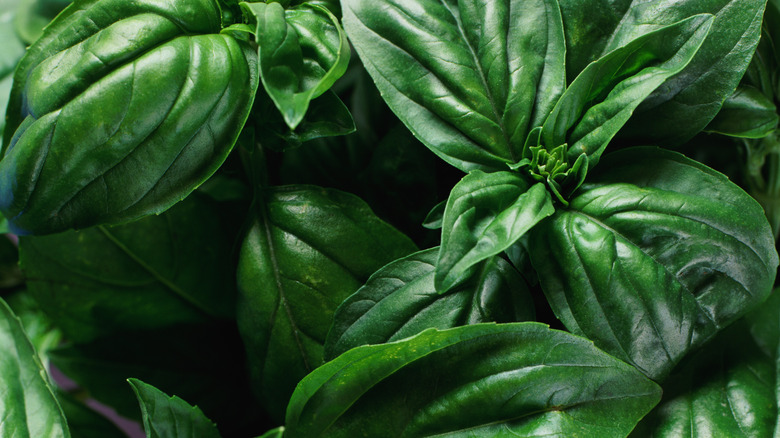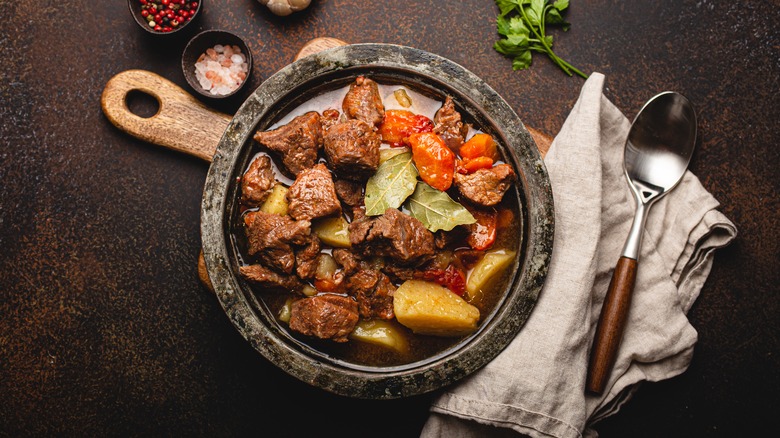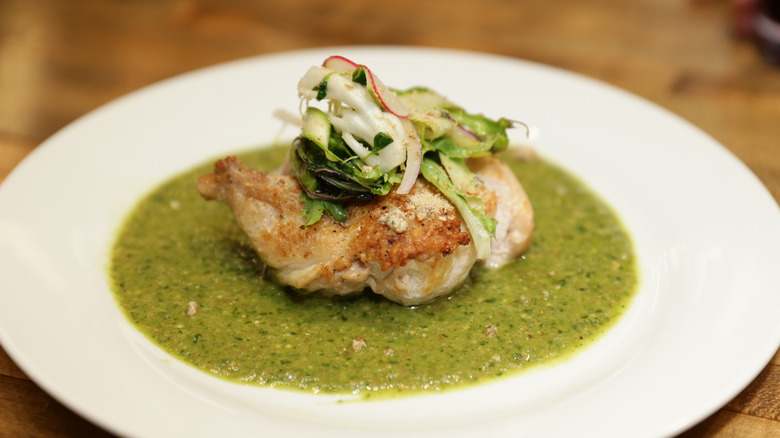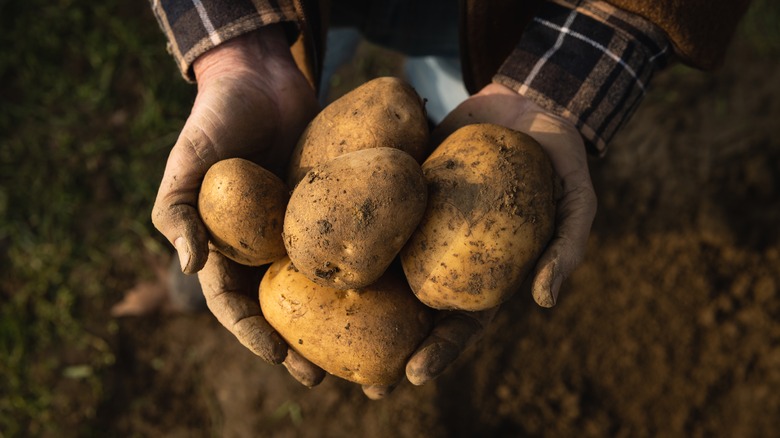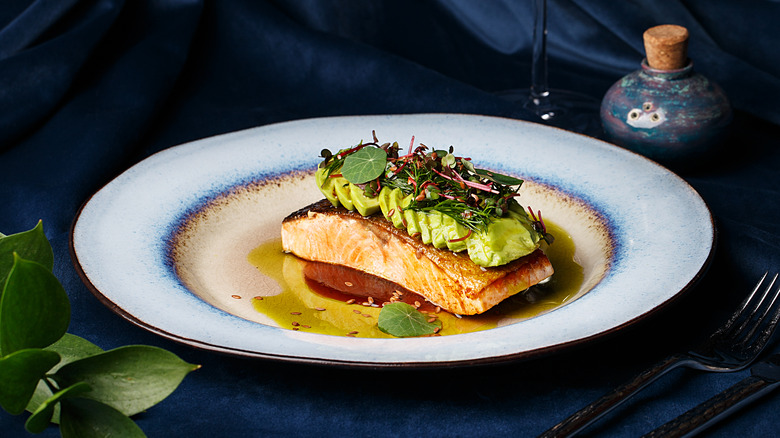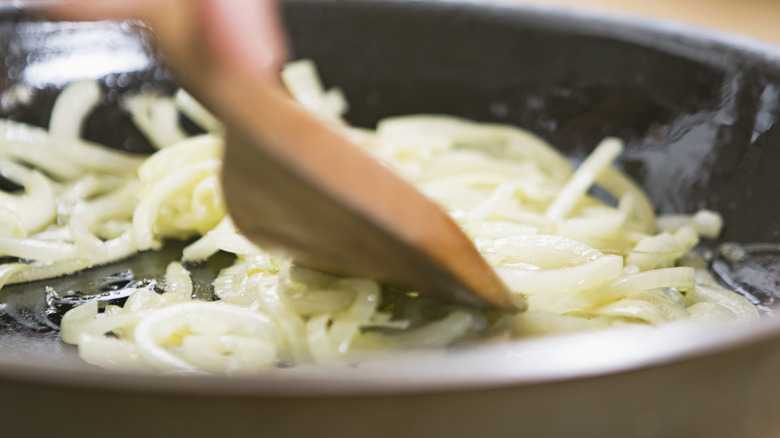French Cooking Tricks You Need In Your Life
To say French cuisine is well-established would be putting it mildly. A more accurate verdict would be that French cuisine is perhaps the most important in the world, this being validated by the cuisine's enshrinement in UNESCO's Intangible Cultural Heritage list. As such a prominent world cuisine, we have the French to thank for many gastronomic inventions, including kitchen vernacular. But the biggest impact French cuisine has had is ultimately how people all across the world approach food and eating.
As explained by The Guardian, during the 19th and 20th centuries, French cooking completely altered how millions of people viewed food. The practice of cooking was transformed from a job to an art, and the legacy of French chefs who worked during this time, such as Auguste Escoffier, is still being felt today.
But despite this esteemed history, in the modern day, French cuisine has a mixed reputation. Many professionals and customers feel as if other, more daring world cuisines have surpassed this antiquated one as the world's finest (via Forbes). For the amateur cook, however, French cuisine still offers countless, incredibly relevant, lessons and tricks that, when mastered, can elevate their gastronomic skills immeasurably. The French cooking tips included in this article are by no means an exhaustive list. However, mastering these will help you form a solid culinary foundation, setting you up to excel no matter what cuisine you are cooking.
Build your mise en place
When it comes to cooking, being prepared will only improve the quality of the end result, and ensuring you are ready for the cooking process is, as Auguste Escoffier School of Culinary Arts highlights, the main reason behind building a mise en place. In a practical sense, a mise en place is composed of all the ingredients a cook needs, pre-prepared and in the correct measurements, meaning all they need to do is add them at the right moment. This allows cooks to concentrate on the task at hand, enabling them to avoid mistakes associated with ill-preparedness, such as inadvertently allowing a sauce to burn as they look for a relevant ingredient.
Even if an individual is competent enough to cook effectively without a mise en place it is still advised they build one. This is quite simply because it allows cooks to fully immerse themselves in the moment, as chef and culinary instructor Barbara Rich explains. "Cooking is a lot more enjoyable when you're organized, and getting ready to cook is almost as important as cooking," she said. "You want to enjoy both parts of it, and then you want to enjoy the food in the end," (via Insider).
Be liberal with butter
As Vogue reports, butter had its reputation tainted by marketing campaigns from the early 20th century. These touted alternative forms of cooking fats as healthier, cleaner, and tastier. It is only now, some 100 years later, that opinions on butter are reverting from one of fear to one of reverence. While many Americans still prefer to flirt with alternatives to butter, French cuisine has always championed the dairy product, emphasizing its use at every turn. The result, as you would expect, is a cuisine that is huge on flavor, a fact reinforced by butter-rich French favorites such as croissants.
Thankfully, this is a tip that is extremely easy to adopt in any kitchen as adding extra butter will greatly improve the final taste and texture of most dishes. In an interview with Love Food, celebrity chef James Martin explained, "Anybody who is a chef will tell you that you can't cook without butter [...] It's just one of those ingredients that it doesn't matter what you do with it, it'll improve your cooking. And it also hits home with everyone because everybody knows about it and has a story to go with it. Nearly every country in the world uses it – whether you're cooking classically French or whether you're doing something Italian or Indian, butter is involved."
Invest time in your sauces
Sauces are one of the hallmarks of French cuisine with the five so-called mother sauces being the most famous. From these five mother sauces springs hundreds of daughter sauces, a fact that has kept the world in rapture with French cuisine, per Auguste Escoffier School of Culinary Arts.
While often overlooked by the home cook, the importance of sauces is immense, as highlighted by chef Henry Harris (via Big Hospitality). "At the risk of sounding like an old codger, it's part of the craft of cookery," said. "I have had some wonderful meals in modern restaurants but many of them don't do proper sauces. To my mind if you sauce a piece of meat or fish then the sauce you use needs to be linked to it. Their first meeting should not be on the plate."
A perfectly made sauce can marry a dish's different flavors together while also providing some much-needed moisture, especially when meat is involved. Yet, fantastic sauces do not come easy. Time and effort must be invested in them to create the depth of flavor for which they are celebrated. Aside from this flavor, an added bonus to homemade sauces is that they are likely to be much healthier for you than store-bought alternatives as these tend to have high fat and salt content.
Take care with presentation
It is not uncommon for the amateur cook to spend hours toiling away at creating the perfect evening feast before slapping the food onto a plate when it's time to eat. Of course, the meal will still taste delicious, but the appearance may leave a little to be desired. Eating, we should remember, is an experience that uses all five senses. As such, careful presentation should be prioritized just as much as flavor building.
French cooking offers ample examples of superb presentation, from the theater-laden masterpieces of Michel Roux Jr. to the artistic flourishes of Joël Robuchon. Yet, for the home cooks, these masterpieces can be intimidating. Chef Brian Poe explains why it is vital to banish these doubts. "Presentation should be approached just like art, cooking, and music," he said. "Take a moment to relax and look at what the others are doing, learn a bit of the technique and then find your own voice and style," (via Lightspeed).
By taking care with your presentation, you create an experience that is not only more enjoyable but also more memorable. For plating novices, it is best to focus on color, size, and texture. Create variation in all of these while remaining mindful of empty space, and you're well on your way to producing a plate of visually appealing food.
Prioritize technique
Technique is integral to all forms of cooking. Not only does it ensure the dish's final quality but also that it can be made consistently — an essential skill for every cook. French cooking is known for being particularly driven by technique thanks to the work of luminary French chefs like the late Paul Bocuse (via Quartz).
While dedicating time to honing basic French techniques, such as knife skills, sauce making, and sauteing may seem like a waste of time given that most cooks can perform a version of them already, doing them correctly will elevate your cooking and provide you with a solid base for further culinary exploration. In an interview with The Manual, chef Patrice Martineau said, "Classic [French] technique is the foundation of all cuisines in the world. In my opinion, it is the most important thing to learn and develop before trying to create anything else in the kitchen. Too many people jump into trying to craft unique dishes before learning the basics of cooking, only being able to make 'fusion food' with no real technique to speak of. For me, that fusion can just be confusion."
Be brave with herbs
While juicy meats and perfectly cooked vegetables take center stage in French cuisine, herbs also play a vital role, especially when it comes to flavor. Both dried and fresh are used throughout the cooking process with Herbs de Provence and tarragon being among the most popular in each respective category (via Auguste Escoffier School of Culinary Arts). As is the case with salt and spices, most home cooks fail to use herbs to the correct degree, often skimping due to fears that they might overpower the dish.
All chefs can learn from French cuisine's liberal use of herbs. For example, a handful of tarragon can temper rich sauces. Using lesser-known herbs can also pay dividends when it comes to cooking, as French-born Michelin-starred chef, Jeremy Gillon explains to The Michelin Guide. "Each herb [such as meadowsweet, verbena, and hawthorn] is quite versatile and entirely depends on which expression or course of the menu I choose to incorporate the herbs in," he said. "Autumn has arrived a bit earlier this year, and we are expecting Jerusalem artichokes, parsley roots, and salsify. These herbs will complement the flavors very distinctly. For proteins, it will be interesting to work with light white meat with a sweet and delicate taste to balance the choice of herbs and their flavor profiles."
Don't discount stews
As cooking has modified, certain types of dishes have found themselves placed on the back burner. Among these are stews, whose unphotogenic appearance has caused them to be sidelined in favor of more Instagram-worthy dishes. But, as The Atlantic reported way back in the 19th century, stews have always been a vital part of French cuisine. That tradition carries on today through ever-popular classics such as beef bourguignon.
Many of us would do well to follow France's lead. After all, stews are among the most flavorful and comforting dishes that can be made. What's more, making a good stew need not be a complicated process. Instead, the vast majority of the flavor comes from trusting a gentle simmer to work its magic over a long period of time. The end result: a dish that might not win you hundreds of new followers but will definitely leave you more than satisfied.
Keep it simple
While there are many aspects of French cooking that people disagree on, one thing is seen as an irrefutable fact: French food is all about refinement and simplicity. Speaking to Luxeat, culinary legend Jacques Pépin explained the importance of this simplicity. "Young chefs try to add this and that to the plate, but when you get older I notice you try to remove unnecessary things and leave the essential one [...]," he said. "Usually these [excellent] dishes are relatively simple, with the most extraordinary ingredients possible, very skillful technique simplicity added to it, usually it strikes your mind. It doesn't happen that often. Even a perfectly roasted chicken with the natural juice is not that easy to get."
No matter what meal you are preparing, keeping your cooking simple will allow your few choice ingredients to sing. What's more, a reduction in processes will simultaneously reduce hands-on cooking time, clean-up time, and opportunities for mistakes to be made. All of these are attractive reasons for novice cooks to employ simplicity within their kitchens. Finally, a reduction in the number of things on the plate will make other culinary tasks, such as presentation and even sourcing good quality ingredients, that much easier.
Use the best quality ingredients
Great food begins with fantastic produce, the building blocks upon which all of a dish's flavors and textures are built. High-quality ingredients are even more important when a stripped-back, simple approach is being taken to cooking as the ingredients have no place to hide. This is a fact that some chefs, like Russell Norman, relish. "There is an inverse relationship between the quality of ingredients and the preparation time of a restaurant dish," he explained. "If your ingredients are simple but exceptional, you need do less to them. Inferior ingredients require more fuss and bother," (via the Independent).
In French cooking, everything from top-quality burgundy wine to soft brie and punchy shallots is used to bring verve and power to dishes. And while not all of us have access to — or can afford — these products, being mindful of where and how you buy your ingredients can instantly upgrade your cooking. If always buying high-quality ingredients is not economically viable for you, focus on ensuring the star of your dish is of fantastic quality, as this will be where most of your diner's attention is focused. This is especially true when it comes to animal protein as the difference between low-quality and high-quality products is immense (via The Michelin Guide).
Layer your flavors
We have seen how quality ingredients and different cooking processes both result in flavor. The next question that should be on a cook's mind is how to meld these flavors together to create the perfect final dish. Balancing, creating, discarding, and manipulating flavors is all part of a process called layering.
Layering is a vital culinary process. It allows a dish to become complex without being confused, and interesting instead of off-putting, according to Culinary Culture. It also happens to be one of the most difficult techniques to master, as three Michelin-starred chef, Anne-Sophie Pic explained to BBC Travel. "That's actually the challenge: being bold in the kitchen, but always preserving harmony...It's not about being daring to end up with something too brutal," she said. "It's all about the subtlety of the tempo."
Fortunately, there are a few simple ways of beginning to build and layer flavor. Here is where technique comes into play. Try mixing different techniques on a plate; perhaps meat could be roasted and vegetables sauteed. The addition of garnishes and sauces can also add extra dimensions to the plate while bringing it all together. Finally, remember to not become disheartened. Learning to layer will take a lot of practice, as it is only through tasting combinations of flavors and textures that you can understand what works and what doesn't.
Approach cooking (and eating) with passion
The meaning and importance of food, cooking, and mealtimes not only varies greatly from culture to culture but also from decade to decade. However, a few countries, such as France and Italy, have managed to maintain respect for these practices across centuries, a practice not widely seen given the periods of rapid industrialization and urbanization that have supercharged all of our lives.
Claude Fischler, a French sociologist and anthropologist, explained the differences between modern approaches to food between France and the United States to The Guardian. "In the US the dominant conception of food is nutritional," said Fischler. "Feeding oneself is above all a matter of making rational decisions to satisfy bodily needs. In contrast, the French have a culinary conception of food, putting the emphasis on flavor and pleasure. In our surveys, we asked French and American people to say what they associated with various words. When we suggested 'chocolate cake,' the Americans thought of 'guilt,' the French, 'birthdays'."
While switching from a U.S. approach to a French one might take time and effort, the ability to approach food as a sensual experience is one that will bring a whole world of joy into both your life and your kitchen, regardless of culinary skill level. As such, it stands as one of the most important points in this whole article. To achieve it we suggest slowing down your cooking and eating rituals in order to savor both the food and the moment.
Cook with a low heat
We have already seen how the low and slow approach benefits dishes like beef bourguignon. However, the benefits of this way of cooking extend far beyond stews. This is because slow, gentle, and prolonged cooking over a low heat results in processes that cannot be replicated via any other means. The most obvious example of this is caramelizing onions, an integral part of a Parisian classic, French onion soup.
Cooking on a low heat can benefit a great number of dishes, especially when the ingredients are particularly vulnerable to heat. Eggs are one such example. The List reports that using the French, low-heat cooking approach when making scrambled eggs results in a finished dish that is softer, richer, and more luxurious than the overcooked, rubbery alternative commonly found elsewhere in the world. All you need is a little patience, and the benefits of low-heat cooking will soon become apparent.
